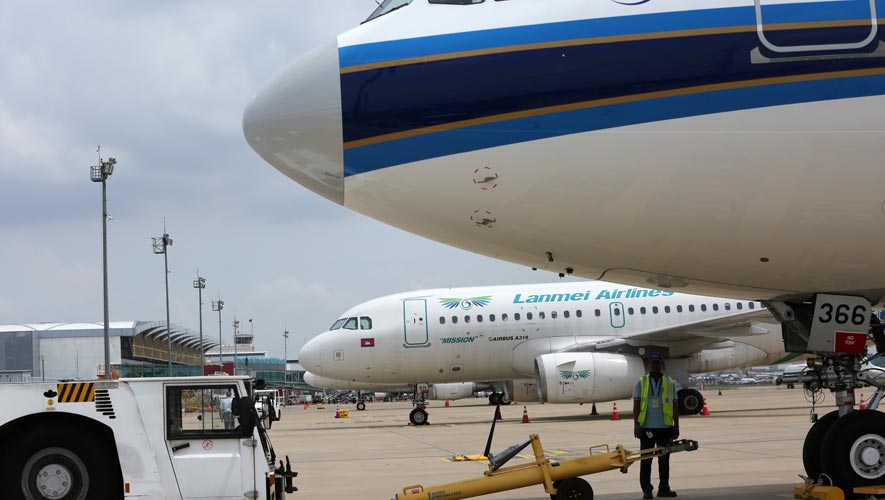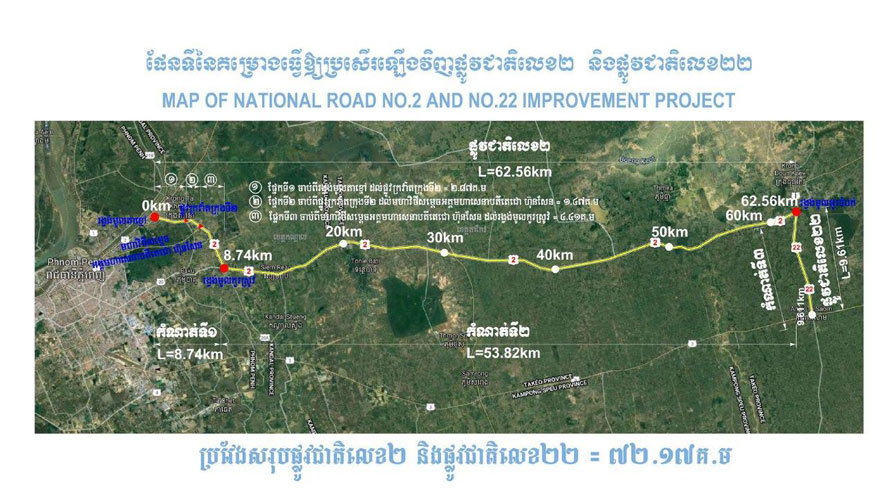Not an airlines per se, the three-year-old airline is reinventing the Cambodian aviation sector with eyes set on e-commerce and non-aeronautical business, to break its reliance on passenger travel
For the latest Cambodian Business news, visit Khmer Times Business
When low-cost carrier Lanmei Airlines started in 2016, there were three other airlines operating, and another applying for an air operator’s certificate (AOC). The three have shutdown since, and the AOC candidate has yet to obtain an approval.
Established on March 7, 2016, Lanmei is a combination of China’s Lanchang River and Mekong River which flows south.
“The river source is in China. It flows through five other countries (Myanmar, Thailand, Laos, Vietnam and Cambodia). Our intention is to link the system through the air, a sky highway connecting China and Southeast Asia in a similar manner with the river,” says Lanmei deputy chief executive officer and chief operation officer Captain Darren Chan.
Its birth amid stiff competition in Cambodia was compounded by crude oil prices that were starting to peak above $50 a barrel from its record lowest in more than a decade.
But the airline owned by Lanmei Airlines (Cambodia) Co Ltd, proved its tenacity with a solid game plan squarely on becoming one of the world’s leading e-commerce airlines.
“Our target is to see our e-commerce revenue exceed our ticket sales by 50 percent in three to five years, making it our main income stream. So, Lanmei is not an airlines, per se which only moves passengers. This is our business model,” says Chan.
Evidently, Lanmei is reinventing the Cambodian aviation sector, smashing monopolies, and capitalising routes and businesses that no longer interest airline giants.
Lanmei’s path is spearheaded by its chairman and chief executive officer Dr Li Kun, who has more than 40 years experience in the industry, says Chan, a pilot himself with 8,000 hours clocked, and an authorised pilot examiner in Cambodia.
The airline has six aircrafts – Airbus 319 (three), A321 (two) and A320 (one) after starting off its maiden flight with one plane on September 29, 2017. Another two Airbus will join its fleet this year bringing the total to eight, effectively making it the largest local airline in the country. Of the fleet, two aircrafts were bought and the rest are dry leased.
The airline serves 25 destinations in China, and five in Southeast Asia. With three competitors gone, the risk of price dumping is minimal but as any new airline start-up, it continues to report losses as margins were squeezed. Although margin is slowly improving, it has yet to settle in a comfortable spot. Its return on its $100 million investment was between seven and eight percent in five years last December, subject to variables including fuel prices.
“Last year, there was a lot of competition because of price dumping by new airlines. The yield was irrational. People were just throwing money but with (the industry) consolidation (as airlines leave), we have some breathing space in terms of yield,” he explains.
Chan says going by Lanmei’s five-year business plan including revenue stream expansion and higher utilisation of planes, the airline will likely record its first-ever profit this financial year ending December 31, 2019.
Its current core business involves transporting passengers, representing some 80 percent of its revenue. The rest of the contribution is from the non-aeronautical segment comprising e-commerce sales via its own platform, a training school for pilots, and “wheels and brakes” technical service for turnaround planes. It has set aside a capital expenditure of $10 million for growth plans this year.
Driving e-commerce, smashing monopolies
The global aviation sector is being steered to invest in e-commerce instead of traditional segments like ground handling, catering and maintenance.
This idea sits well with Lanmei, which not only provides logistical service including door-to-door delivery but also has its own e-commerce platform that enables Chinese suppliers market their products.
Chan says the concept is like American retail chain Walmart Inc, which earns a sales revenue from products advertised there.
“Similarly, our value chain is able to move the products, all we needed was a platform. We are investing heavily in this model because it has a huge market and potential,” Chan says.
The platform sells various products from souvenirs, inflight meals, and hotels right up to second-hand cars. “For cars, the customer needs to just go online, select the item, pay a deposit and we will coordinate the rest. We have partners that can import second-hand cars into Cambodia,” Chan says.
Lanmei envisions a future in online supermarket which is a first in Cambodia. “We want the platform to be a brandname for product advertisement,” he adds.
The airline hopes the e-commerce business would give it the competitive edge to take on big players like AirAsia or Cathay Pacific.
Meanwhile, Lanmei plans to start external aircraft cleaning services, catering, and providing third party spare parts maintenance which it sees as a precursor to establishing a maintenance, repair and overhaul (MRO) service for commercial planes in Cambodia. This would inadvertently cut the cost of doing business in Cambodia, which stems from monopolised outsourcing services.
“Outsourced services in this sector is expensive particularly if it is a monopoly. They are also not up to your standard. We want to break these monopolies by branching out to catering, and ground handling although we are aware that these services are tied to concessions.
“We want to provide external aircraft cleaning too which is not available in Cambodia as no one has the tools,” he says.
Presently, Lanmei does aircraft line maintenance, a service that is also extended to Chinese airlines that fly into Phnom Penh, Siem Reap and Sihanoukville. The airline is certified to do the checks after obtaining the civil aircraft maintenance organisation certification (Certificate 145) from the Civil Aviation Administration of China.
“Our job is to check any snags. Our engineers are on hand to troubleshoot. This service is part of the routine checks done on planes before they are released for take off. We have been doing this for half a year now. It is an area that no one wants to invest because of high capital,” Chan says.
On its own, Lanmei is undeterred by challenges including its goal of becoming the second food caterer and ground handler in Cambodia. It is coming up with a strategy to obtain the licenses for these business.
Global airline caterer Zurich-based Gate Gourmet Switzerland GmbH is the sole provider in Cambodia now but Lanmei is in talks with the government for an opportunity for a second catering licence. Similarly, it is engaging with the State Secretariat of Civil Aviation on ground handling.
Growing through the cracks
For an airline to grow, its network should expand. Hence, its active codeshare pursuit with established airlines that fly to Thailand as it is a “melting pot for airlines in the world”, and an alliance for the Chinese market.
“We fly daily to Bangkok at half the price of Bangkok Airways. Thailand is a strategic place for codesharing. Many Cambodians also fly to Thailand for medical purposes. Low-cost carriers can thrive in that short sector. It is an impact on margin but it is something airlines have to absorb when developing the market,” he adds.
Chan claims that its ticket price is very competitive, particularly to Hong Kong and Guangzhou based on the view that since it is a newcomer, it has to sell tickets at reasonable rates.
“Hong Kong Airlines which is a full service airline is double or triple our fares. Most of the time, the short sectors (within two to three hours) are sweet spots for low-cost carriers. Singapore Airlines and Malaysia Airlines are out of the game in this sector,” he says.
However, he notes that the tricky routes are Hong Kong and Bangkok as it goes up against airline giants like Cathay Pacific, Hong Kong Airlines, and Bangkok Airways, all of which have network capabilities to codeshare and connect to other parts of the world.
“They have this additional advantage, so we feel challenged going against these giants but we still need to do it,” says the former AirAsia pilot.
As for its Chinese routes, Chan claims all of them are profitable. Lanmei will add another five cities in northeast China, along with Manila, Taiwan and Kuala Lumpur by the end of the year.
“Not everyone can fly to China, particularly newcomers because the slots are pretty much used up. In China, one must first prove operation capability, only then it can get slots,” he says.
Moving forward, despite fierce competition among giant low-cost carriers like AirAsia in the region which fly overlapping routes, Lanmei is prepared to go all out.
“AirAsia used to be competitor, a force to reckon with but as most large budget airlines become older, they carry more fat. They are not lean and mean like before. Once you lose track of cost, you lose track of management. Such airlines find themselves in a position where it is slightly harder to manoeuvre competition.
“So that gives us room to capitalise. We go for the crumbs which do not matter to them as it is too small. As a start-up it is good for us because we are nimble. We can go in and out fast but we must be mindful that as we grow older, so we must remain nimble too,” he adds.




